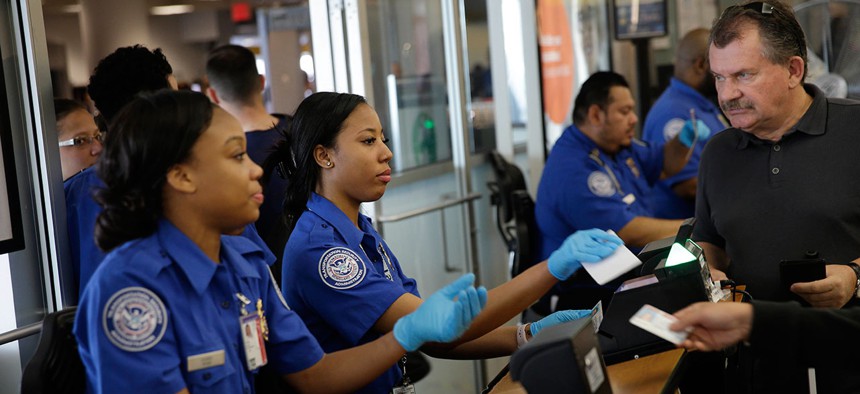
Transportation Security Administration employees check passengers' identifications at a security check point at LaGuardia Airport in May. Seth Wenig/AP
Identifying ‘Suspicious’ Passengers is Where Customer Service Meets National Security
In the air, it’s up to the flight crew to differentiate between personal bias and objective threat.
Since first surfacing in 2002, “If you see something, say something” has come to exemplify the idea that average Americans are the first line of defense against terrorist attacks. The only problem? “Something” is pretty ambiguous.
The US Department of Homeland Security defines suspicious activity as “any observed behavior that could indicate terrorism or terrorism-related crime,” noting that “factors such as race, ethnicity, and/or religious affiliation are not suspicious.” In practice, though, citizen-surveillance is often hamstrung by stereotyping and prejudice, which can easily lead to false alarms.
Nowhere is this tension on greater display than in flight. In April, a Muslim college student was removed from a Southwest Airlines flight and questioned by the FBI after a fellow passenger overheard her speaking Arabic. Earlier that month, an Arab-American family was removed from a United flight for similar reasons. And late last year, four passengers described by other passengers as Middle Eastern werebooted from a Spirit Airlines flight. (In all of these cases, the airlines dispute that bias was a factor.)
“People are singled out because they look/smell/sound ‘foreign’ or different,” said Richard Bloom, a professor and airline security expert at Embry-Riddle Aeronautical University. “Often their English seems to not be ‘very good.’ Or stereotypical behaviors linked to terrorism from novels, films, videos, and news accounts are misinterpreted.”
Actions speak louder
In the air, it’s up to the flight crew to differentiate between personal bias and objective threat, which can be tricky, since overruling a nervous passenger generally means breaking the cardinal rule of customer service.
“When a passenger complains about another passenger, I can’t ignore it,” says Heather Poole, a flight attendant for a major U.S. airline and the author of Cruising Attitude: Tales of Crashpads, Crew Drama and Crazy Passengers.
Crew members must decide as a team whether a passenger complaint is legitimate. All flight attendants have guidelines for what’s considered suspicious, and while no airline contacted by Quartz would share those guidelines, several flight attendants interviewed said they’re trained first and foremost to look at behavior.
“Air travel is full of disruptions, like delays, and passengers sometimes suffer from conditions like claustrophobia or hypoglycemia when flying,” says Chris Manno, a captain of 25 years with a major U.S. carrier. “All these things can provoke unusual behavior in a normal person—until we talk to them, we have no idea what condition might have affected their behavior.”
That conversation between a crew member and a “suspicious” passenger is crucial, flight attendants say, both for assessing body language and weeding out potential bias on the part of the complaining party.
“When a passenger voices concerns to me about another passenger, I get as much information about why, specifically, they are uncomfortable,” says Sarah Steegar, a flight attendant of 19 years and a columnist at FlyerTalk.com. “[Then] I engage in conversation with the ‘suspicious’ passenger to gather information and feel out the person myself. Even if I decide there is no issue, I share with the entire crew what happened to inform, get additional opinions and provide an opportunity for colleagues to take further actions if there is any difference of opinion.”
While details varies by airline, crews usually go through six to eight weeks of security training, plus ongoing computer-based courses and in-person seminars. A Transportation Security Administration document leaked last year showed that crews are taught to look for suspicious behaviors that include fidgeting, perspiration, and evasive responses to questions.
“[The guidelines] don’t have anything to do with appearance or other subjective issues,” says Manno. “It’s pretty well spelled out—what’s a threat and what’s not a threat.”
That’s important, he says, because ethnic profiling can actually make us less safe: Focusing on appearances ignores that appearances are easily manipulated.
Singled out
Of course, mistakes happen. In November, Bilal Rana, a Muslim doctor from Houston, said he was unjustly profiled by a fellow passenger on a Southwest flight because he was wearing a white shalwar kameez, a traditional South Asian outfit that consists of loose trousers and a long shirt. Rana was detained by the FBI and questioned after the flight. Still, he urges other Muslims to “rise above it” if they find themselves in a similar situation.
“All we can do [as Muslims] is our part,” Rana says. “Their part—the authorities’— is to ensure that they exercise surveillance not just diligently but…without undermining the dignity of those they surveil.”






